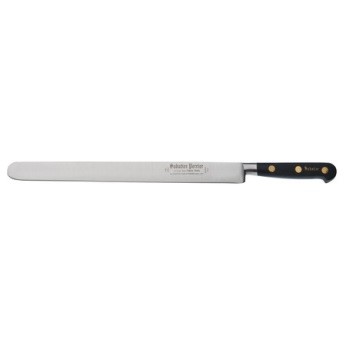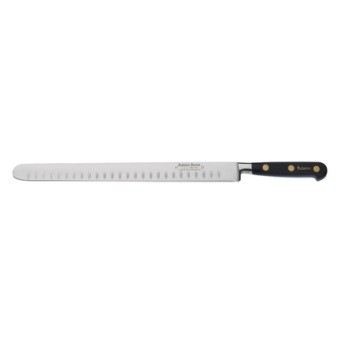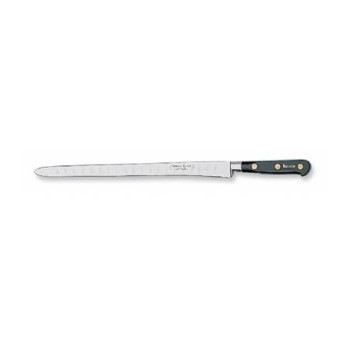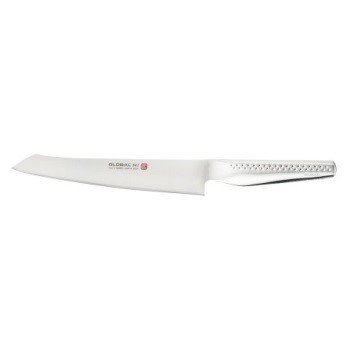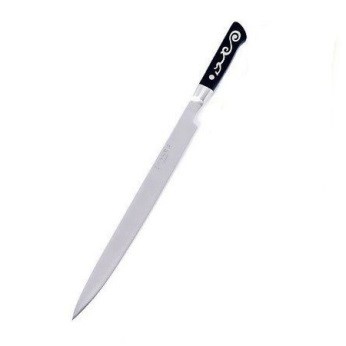Christmas & New Year Trading
Website: Open 24/7 for on-line ordering.
Customer Service/Warehouse: Closed 12pm Monday 23rd December 2024, re-opening 8:30am Thursday 2nd January 2025.
All orders placed over the holiday period will be processed in the New Year.
We wish all of our customers a Merry Christmas and a Happy New Year.
Guide to Carving and Slicing Knives
Click on the following links to jump to the relevant sections:
Carving and slicing knives may look similar but they do have different purposes when it comes to cutting meat. Choosing the right blade for the meat you are cutting is vital, as blades that are too flexible will not be tough enough to cut comfortably through the meat and will make ragged cuts, while blades that are too stiff can be difficult to control.
Both types of knife have blades of at least 15cm to provide enough room to work with — with shorter blades, cuts must be made up to the bolster, making longer strokes very difficult. Both types of knife need to be extremely sharp to avoid employing undue pressure when cutting, as this can produce uneven slices as well as tear the meat, making it tougher to eat.
Carving and slicing knives facts box
The following table outlines some of the features specific to carving and slicing knives, including the uses to which they are put:
Knife Type |
Size |
Style |
Flexibility |
Uses |
|
Carving Knife |
Around 20cm |
Thicker, ridged blade with a curved pointed tip for disjointing and cutting meat away from the bone. |
Ridged blade for more control when carving. |
Carving roasts and poultry. |
|
Slicing Knife |
15cm – 25cm |
Long and very narrow with a straight edge for cutting against a board and slicing large chunks of meat with few bones. Can have a pointed or blunt tip. |
More flexible blade for cutting thinner slices of roast. |
Slicing large roasts, pork, venison and fish. Can also be used for slicing fruit and vegetables. |
Price guide
Carving and slicing knives vary in price from less than £10 to well over £100. It’s important to bear in mind that when buying one of these knives you may also need to purchase a carving fork which, again, vary in price from less than £10 to around £50. These types of knives need sharpening regularly but blades with fluted or scalloped edges generally hold their edge for much longer than straight blades so are a good low maintenance option.
Best carving and slicing knives
Below is a range of the best carving and slicing knives available for your kitchen:
Image |
Knife |
Description |
Cost |
 |
Granton Beef Slicing Knife 25cm
|
The scalloping of the Granton Edge creates air pockets between the blade and the meat which reduces friction and minimises the risk of tearing, allowing the meat to fall away from the knife. The scalloping also helps to maintain the sharpness of the edge. |
|
 |
Masterclass Forged Carving Knife 22cm
|
One of the best options for a budget carving knife which doesn’t compromise on quality. This carving knife costs less than £10 and is made from fully forged full tang stainless steel, making it highly durable. |
|
 |
Sabatier Slicer/Carving Knife Pointed 25cm
|
A great mid-range Japanese-style knife made from a single piece of hot drop forged stainless. The thin blade makes easy work of both meat and fish, while the pointed end is excellent for working around bone. |
|
 |
Global SAI Series SAI - 02 Carving Knife 21cm
|
At the top end of the price range is this beautiful carving knife from Global’s SAI series. The solid core of the blade is covered by layers of stainless steel which extends to the handle, making this knife super strong. The blade is hammer finished to create small air pockets which prevent food from sticking to the blade. |
* Ex VAT
Sets
Carving and slicing knives can be very expensive as they perform such a specialist job in the kitchen and need to stand up to being honed regularly. For these reasons, knife sets containing these knives tend to cost more than basic sets. However, sets with these knives often also contain carving forks and honing steels so are a superb investment for a full carving kit.
- Wusthof Classic & Gourmet Chef’s Knife Set Master Case - £371.24
- Global 7 Piece Limited Edition M. R. Knife Set - £250
- Block Wooden Victorinox Set With 10 Knives & Steel Moulded Handle - £169.60
How to perfectly carve a roast
A roast dinner is a customer favourite in pubs, restaurants and carveries. Many chefs have their own tricks and tips on how to make the perfect roast, with much pride and satisfaction taken in the quality of the final outcome. But all that effort can be undone in the final carving process if care is not taken.
Below are some tips on the best way to portion out your cooked meat:
- Let the meat stand for up to 20 minutes. This lets the juices redistribute throughout the meat and prevents less juice from spilling out as the meat is cut, keeping it moist.
- Slice, don’t saw. Use the full length of the knife with each stroke, travelling in a single direction.
- Cut against the grain of the meat. The grain is the direction in which the muscle and tissue fibres align. Cutting through the fibres shortens them, making the meat less tough.
- After the meat has been cut into slices, immediately move them to a warmed plate, spooning any of the juices that have run out over the slices to keep the meat moist.
- Avoid serrated blades, these tend to tear the meat. This does not hold true for Granton Edge blades, which feature scallops that reduce surface friction and make slicing easier.
- When carving poultry breast, start at the wing end and work back.
Carving and slicing knives FAQs
Here are some popular questions around the subject of carving and slicing knives:
- Do I need a carving knife?
- What is the best knife for carving meat?
- How do you sharpen a carving knife?
- What is the difference between a chef’s knife and a carving knife?
- Should I use an electric carving knife?
1. Do I need a carving knife?
If you really had to, you could operate in the kitchen with just one knife. However, this would be difficult and time-consuming. Specialised knives have been developed to speed up time when preparing and serving food — time that is crucial in a professional kitchen.
The long thin design of most carvings knives also allows for greater precision sectioning the meat, which greatly impacts on the presentation of the plate and how it is received by customers. The thinner blades also produce less drag on the meat, keeping it intact.
2. What is the best knife for carving meat?
Different types of meat and the cuts you can use all have their own unique properties. You should consider the following points before choosing a carving or slicing knife:
- Will you need to carve around bone?
- Do you need to produce thin, even slices?
- How wide is the cut of meat you are slicing?
- How tender is the meat you are using?
The following guide will give you an idea about which type of knife is best for which occasion:
3. How do you sharpen a carving knife?
Like all blades, carving knives perform best when they are kept as sharp as possible. Honing before use is always recommended before carving. The blade itself can be sharpened using any of the traditional methods:
- Whetstone
- Tabletop sharpener
- Grinding wheel
4. What is the difference between a chef knife and a carving knife?
The blade of a carving knife is both thinning in width and in the thickness of the metal itself, producing thinner slices than a chef’s knife. The point at the end of a carving knife is designed to get into difficult areas around a joint to help separate meat from bone. Carving knife blades are also more flexible to make this task easier.
5. Should I use an electric carving knife?
Electric carving knives have no place in a professional kitchen. Their size and serrated blade can rip and tear food, while their bulk makes it difficult to perform delicate cuts. When working around bone, a handheld knife is the best option. For large pieces of boneless meat, a meat slicer is easy to use, leaves less waste and will produce thin, even slices with none of the drawbacks of an electric knife.
Check out our other knife guides here:
17 June 2016






